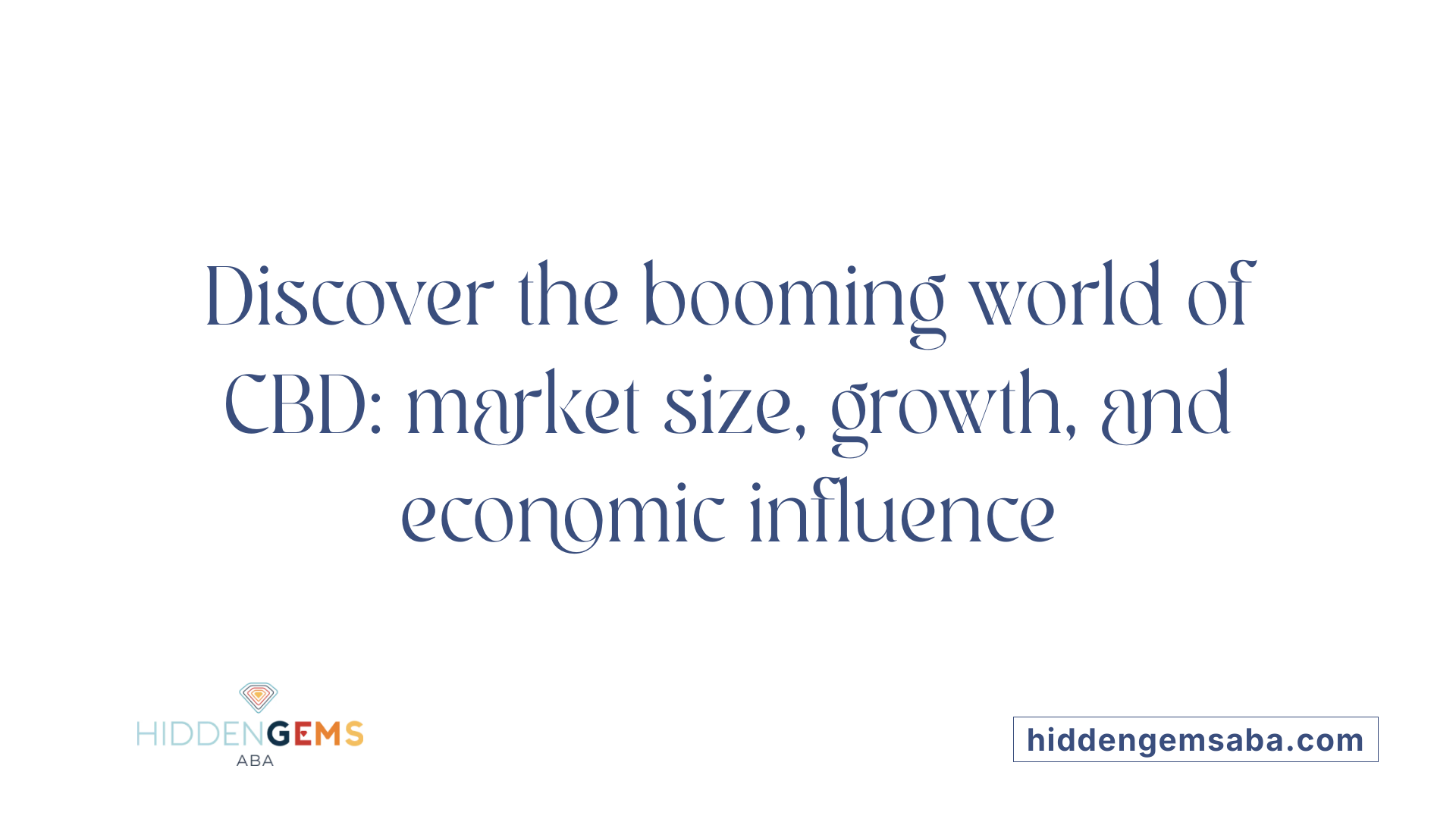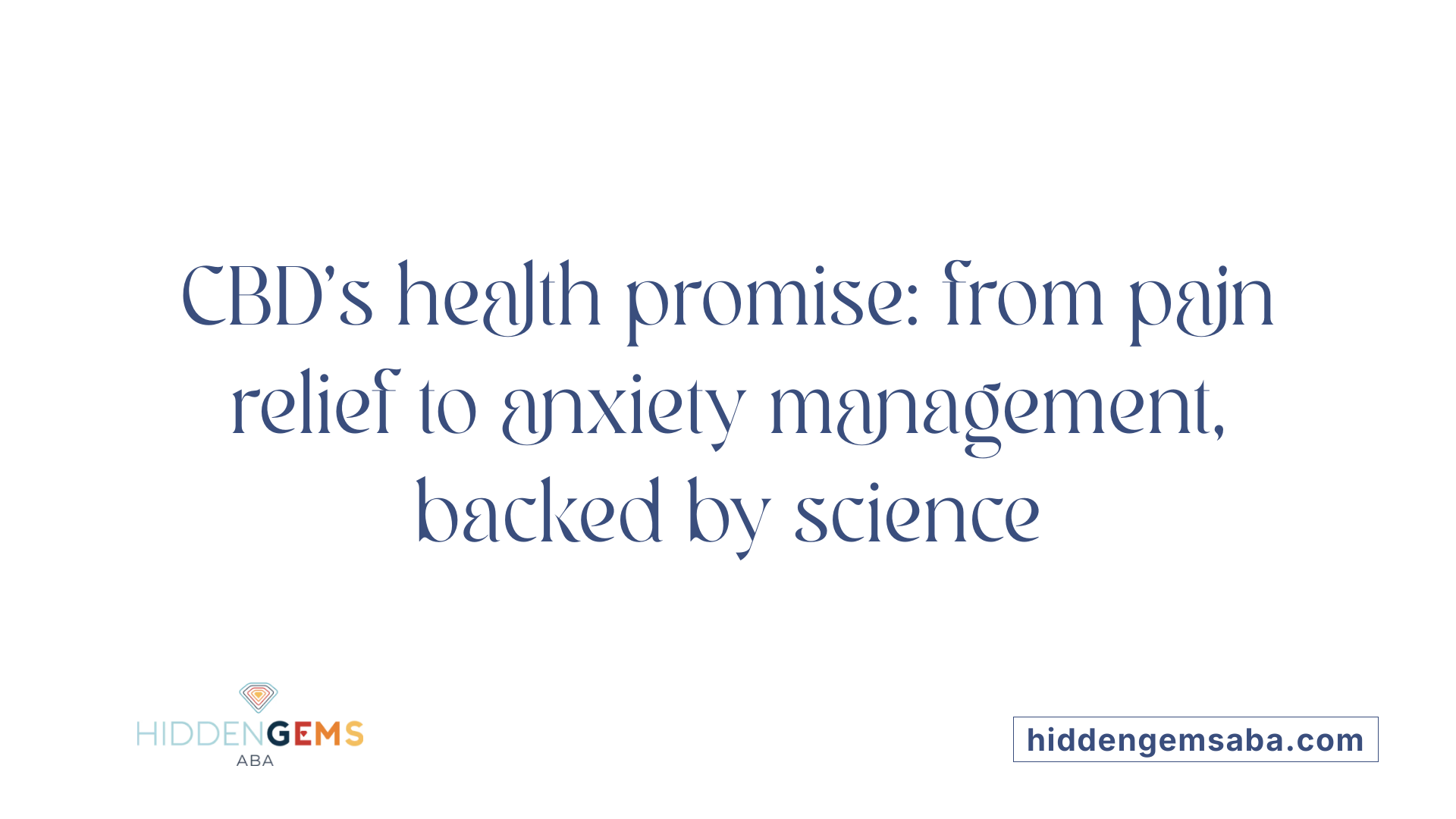Introduction to CBD and Its Growing Relevance
Cannabidiol, commonly known as CBD, has emerged as a significant component in wellness and therapeutic markets worldwide. With increasing legality and consumer interest, understanding the statistical landscape of CBD usage, market growth, and therapeutic applications is crucial. This article delves into the current data surrounding CBD, highlighting market trends, user demographics, and the scientific advancements underscoring its therapeutic potential.
Overview of the CBD Market Growth and Economic Impact

What is the current size of the CBD market?
The CBD market has experienced significant expansion, with recent estimates valuing it at several billion dollars globally. This rapid growth is fueled by increasing consumer acceptance and legalization trends worldwide.
How fast is the CBD market growing?
Market growth rates for CBD products are remarkably high, often surpassing double-digit percentages annually. Projections suggest the market could continue this upward trend, doubling within the next few years.
What is the economic impact of the CBD industry?
The CBD industry contributes billions to the economy through job creation, manufacturing, retail, and taxation revenues. It also stimulates ancillary industries such as agriculture, packaging, and marketing.
What are the consumer sales trends?
Consumer demand is shifting towards high-quality, diverse CBD products. Sales have surged particularly in sectors like wellness and personal care, indicating broader acceptance beyond traditional medicinal uses.
Which CBD product categories are most popular?
Popular product categories include oils and tinctures, edibles, topicals, and beauty products. The variety shows consumers' increasing interest in integrating CBD into everyday lifestyles.
These trends underscore the dynamic nature of the CBD market and its growing importance to the global economy.
Demographics of CBD Users: Who Is Using CBD?

What Age Groups Are Using CBD?
CBD usage spans a wide range of age groups, but it is particularly popular among adults aged 18 to 45. Younger adults often turn to CBD for stress relief and general wellness, while older adults are more likely to use it to manage chronic pain and sleep issues.
What Is the Gender Distribution Among CBD Users?
Both men and women use CBD, but studies show a slightly higher usage among women. Women often cite anxiety and sleep improvement as their primary reasons for use, whereas men are more likely to use CBD for physical performance and recovery.
What Are the Common Reasons for Using CBD?
Users report a variety of reasons for incorporating CBD into their routines, including pain relief, anxiety reduction, improved sleep, and overall wellness. Some also use CBD products for specific conditions such as arthritis or migraines.
How Does CBD Usage Differ Geographically?
CBD use tends to be higher in urban areas, particularly in regions where cannabis laws are more relaxed. The West Coast of the United States, for example, sees higher adoption rates compared to other regions.
What Are CBD Consumers' Behavior Patterns?
Consumers often prefer gummies, tinctures, and topical products for ease of use. Repeat purchasing is common among users who find consistent benefits, and many are inclined to seek products with clear labeling and third-party testing for quality assurance.
Therapeutic Applications of CBD: Potential Benefits and Scientific Backing

What Are the Therapeutic Uses of CBD?
CBD, or cannabidiol, is widely recognized for its potential to alleviate symptoms of various health issues without causing the psychoactive effects associated with THC. Many people use CBD to manage chronic pain, reduce anxiety and depression symptoms, and improve sleep quality. Additionally, it is being explored for its anti-inflammatory properties and its possible benefits in neurological disorders.
What Does Scientific Research Say About CBD’s Benefits?
Numerous studies have highlighted CBD's potential therapeutic roles. Clinical trials have shown it may help reduce seizure frequency in certain epilepsy syndromes, such as Dravet syndrome. Research also points to CBD's anti-anxiety effects, with studies reporting reduced anxiety in patients exposed to stressful conditions. Moreover, its anti-inflammatory and neuroprotective qualities are under active investigation, promising broader medical applications.
Which Conditions Are Commonly Treated With CBD?
CBD is frequently used for conditions including chronic pain, epilepsy, anxiety disorders, insomnia, and arthritis. Patients often turn to CBD when traditional treatments have limited effectiveness or cause unwanted side effects. It is important to note that while CBD shows promise, not all conditions respond equally, and further studies are needed to confirm efficacy.
How Does CBD Differ From Other Therapies?
Unlike many pharmaceutical treatments, CBD is generally considered well-tolerated with a favorable side effect profile. It offers a non-intoxicating alternative to THC and conventional medications, appealing to those seeking natural or adjunctive options. Its mechanism, interacting with the endocannabinoid system, distinguishes it from other therapies that may target different biological pathways.
| Aspect | Details | Additional Information |
|---|---|---|
| Therapeutic uses | Pain relief, anxiety reduction, epilepsy treatment | Also explored for neuroprotection and anti-inflammation |
| Scientific backing | Clinical studies, trials in epilepsy and anxiety | Research ongoing for expanded indications |
| Commonly treated conditions | Chronic pain, epilepsy, anxiety, insomnia | Often used when conventional therapies are inadequate |
| Differences from other therapies | Non-psychoactive, natural origin, endocannabinoid action | Typically better tolerated with fewer side effects |
Legal Status and Regulatory Landscape of CBD Globally

How is CBD Legal Worldwide?
Cannabidiol (CBD) legality varies significantly across countries. In many nations, CBD derived from hemp with less than 0.3% THC is legal either for medicinal or recreational use. However, some countries still prohibit CBD entirely or only allow it with a prescription due to concerns about psychoactive effects. The diversity in laws reflects differing national drug policies and health regulations.
What Are Common Regulations on CBD Products?
Regulations typically focus on several aspects:
- THC content limitations: Most jurisdictions set a maximum THC level, often 0.3% or lower.
- Product labeling: Accurate disclosure of ingredients and dosages is mandatory.
- Medical claims: Many countries restrict unproven health claims on CBD products.
- Quality controls: Standardized testing for contaminants and potency boosts consumer safety.
How Do Regulations Impact Market Trends?
Strict regulatory frameworks contribute to more transparent and competitive markets by building consumer trust. Conversely, ambiguous or fragmented regulations often hinder market expansion and innovation due to legal uncertainties. Countries with clearer laws tend to see a rise in CBD product diversity and consumer adoption.
What Quality Control Standards Are in Place?
Quality control standards include:
- Third-party lab testing for purity and cannabinoid profile.
- Good Manufacturing Practices (GMP) to ensure product consistency.
- Traceability systems that verify the source of hemp and additives. These requirements help curb the risk of adulterated or mislabeled products, ensuring high-quality offerings globally.
Consumer Preferences: Popular CBD Product Types and Consumption Methods
Oils and Tinctures
Oils and tinctures remain among the most popular CBD products due to their versatility and ease of use. Users typically administer drops sublingually, allowing for faster absorption and more controlled dosing compared to other methods.
Edibles and Capsules
CBD edibles and capsules offer a convenient, discreet way to consume CBD, favored by those looking for pre-measured doses. Gummies are especially prevalent, combining appealing flavors with consistent CBD intake.
Topicals and Creams
Topical CBD products, including creams and balms, are used mainly for localized relief. Consumers seeking to target specific areas for pain or inflammation often prefer these applications.
Vaping CBD
Vaping has gained popularity in recent years thanks to its rapid absorption and high bioavailability. However, user concerns about safety and regulatory scrutiny have caused some shifts away from vaping towards other methods.
Trends in Consumption Methods
Recent trends indicate a diversification in consumption preferences, with more consumers exploring a combination of methods depending on their lifestyle and health goals. Convenience and product innovation continue to drive the market, while safety and transparency remain significant factors influencing consumer choices.
Safety, Quality Control, and Challenges in the CBD Industry
What Are the Main Product Quality Issues?
Product quality issues in the CBD industry often stem from contamination, inaccurate labeling, and inconsistent potency. Some products have been found to contain harmful substances like pesticides or heavy metals, while others lack the advertised amount of CBD. These discrepancies compromise consumer trust and safety.
How Prevalent Are Testing and Certification Rates?
Despite the growing demand, testing and certification remain limited. Studies suggest that only a minority of CBD products undergo rigorous third-party testing. Certifications ensure that products meet safety and potency standards, but uneven regulation means many products escape thorough scrutiny.
What Are the Consumer Safety Concerns?
Consumers face risks including ingestion of unregulated additives, exposure to contaminants, and adverse interactions with medications. Without uniform standards, potential hazards remain high, emphasizing the need for more transparent labeling and safety oversight.
What Challenges Exist in Standardization?
A major challenge is the lack of consistent regulatory frameworks across regions, leading to widely varying product standards. Additionally, the diverse sources of hemp and extraction methods complicate efforts to establish universal quality metrics. This fragmentation hinders industry-wide assurance of product safety and efficacy.
Public Perception and Awareness of CBD and Its Effects
How aware are people about CBD?
Awareness of cannabidiol (CBD) has significantly increased in recent years, with many adults now familiar with its existence and potential uses. Surveys indicate that a substantial portion of the population recognizes CBD as a compound derived from the cannabis plant, often associating it with health and wellness products.
What are the current public perception trends?
Public perception generally leans positive, with many viewing CBD as a natural remedy for various ailments such as anxiety, pain, and sleep issues. However, opinions vary, and some remain skeptical due to limited regulation and scientific consensus.
What common misconceptions about CBD exist?
Misconceptions include confusion between CBD and THC, leading some to wrongly believe CBD causes psychoactive effects. Others think all CBD products are legal everywhere, despite differing regulations. Additionally, some expect CBD to be a cure-all, which is not supported by evidence.
How do media and marketing influence public views on CBD?
Media coverage and marketing campaigns play a major role in shaping perceptions, often highlighting positive testimonials and benefits. This can increase interest but also contribute to unrealistic expectations. Conversely, sensationalized or negative reporting can foster doubt and misinformation.
This overall mix of awareness, perception, misconceptions, and media influence shapes the evolving public understanding of CBD today.
Emerging Trends: Innovations and Future Directions in CBD Use

What are the new product developments in CBD?
Recent innovations in CBD product offerings include the expansion of delivery methods beyond traditional oils and capsules. New formulations such as CBD-infused beverages, topical creams with enhanced absorption technology, and even transdermal patches are gaining popularity. These advancements aim to improve ease of use and targeted therapeutic effects.
How is clinical research on CBD advancing?
Clinical research continues to broaden with ongoing trials exploring CBD's efficacy in treating conditions like anxiety, epilepsy, and chronic pain. Novel studies are investigating optimal dosing and long-term safety profiles. Emerging evidence supports CBD's anti-inflammatory and neuroprotective properties, fueling further scientific interest.
How is CBD integrating with other therapies?
CBD is increasingly being combined with other natural compounds and pharmaceuticals to enhance therapeutic outcomes. For example, integrating CBD with traditional pain management regimens is showing promise in reducing opioid dependency. Additionally, synergy with other cannabinoids and terpenes is a focus to optimize the entourage effect.
What are the projections for market expansion?
The CBD market is projected to grow significantly in the coming years, driven by increasing consumer acceptance and regulatory clarity in various regions. Experts forecast a surge in product variety and accessibility, alongside global expansion, particularly in wellness and medical sectors.
These emerging trends collectively signal a dynamic future for CBD applications, highlighting innovations that enhance efficacy and broaden its use spectrum.
Economic and Social Impact of CBD Industry Growth
How has job creation been influenced by the expansion of the CBD industry?
The growing CBD industry has significantly boosted job creation across various sectors, including agriculture, manufacturing, retail, and marketing. This expansion has opened numerous employment opportunities ranging from cultivation and processing to distribution and sales.
What are the current investment statistics in the CBD market?
Investment in the CBD industry has surged dramatically, with billions of dollars poured into startups and established companies. Venture capital, private equity, and public markets have all shown strong interest, reflecting confidence in sustained industry growth.
How has social acceptance of CBD evolved?
Social acceptance of CBD products has increased as more consumers become aware of its potential benefits and legal frameworks become clearer. This acceptance has led to broader market penetration and mainstream retail availability.
What is the impact of CBD industry growth on healthcare practices?
The rise of the CBD industry has influenced healthcare by encouraging more research into its medicinal properties and integrating some CBD products into wellness and therapeutic applications. Healthcare providers are gradually considering CBD as a complementary option, especially for pain management and anxiety treatment.
Challenges to Market Growth: Regulatory, Scientific, and Social Barriers
What Are the Regulatory Hurdles for CBD Market Growth?
The CBD market faces a complex regulatory landscape that varies by country and even by region. In many places, unclear or evolving regulations create uncertainty for producers and retailers, making it difficult to ensure compliance. These hurdles delay product launches and increase costs related to legal consultation and certification.
How Do Scientific Uncertainties Affect the CBD Industry?
Scientific research on CBD is still in its early stages, leading to gaps in understanding its full therapeutic potential and safety profile. This lack of comprehensive clinical data limits the FDA and other authorities from endorsing definitive health claims, which in turn affects consumer confidence and restricts product innovation.
What Social Stigmas Impact the Market?
Despite growing acceptance, CBD continues to suffer from social stigma linked to its association with cannabis. Some consumers remain wary of its psychoactive cousin THC, leading to skepticism about CBD's benefits and legality. This stigma can deter potential buyers and limit mainstream adoption.
How Do Insurance and Reimbursement Issues Challenge Market Growth?
Another barrier is the lack of insurance coverage for CBD-based treatments. Without reimbursement options, the cost burden falls entirely on consumers or patients, which can reduce accessibility and limit widespread use, especially for therapeutic applications.
| Challenge Area | Description | Impact on Market Growth |
|---|---|---|
| Regulatory Hurdles | Unclear rules and regional differences | Delays, increased compliance costs |
| Scientific Uncertainties | Limited clinical evidence on efficacy and safety | Limits product claims, affects consumer trust |
| Social Stigma | Negative perceptions from cannabis association | Reduces consumer willingness |
| Insurance Issues | Lack of reimbursement options | Increases out-of-pocket costs, restricts access |
Conclusion: The Future of CBD in the Market and Therapeutic Landscapes
As CBD continues to gain momentum across global markets and medical fields, comprehensive statistics underscore both its potential and the challenges ahead. The expanding consumer base, innovation in product types, and growing body of scientific research point to a promising future for CBD. However, regulatory clarity, quality assurance, and continued education will be critical to sustain growth and maximize therapeutic benefits. Ultimately, the evolving CBD landscape presents a dynamic opportunity for economic, social, and health advancements.
References
- Applied Behavior Analysis (ABA)
- How to Become an Applied Behavior Analyst (ABA) Therapist
- How to Become an ABA Therapist - School of Education
- Licensure of Behavior Analysis in the United States
- Applied Behavior Analysis (ABA)
- Applied Behavior Analysis (ABA)
- Applied Behavior Analysis (ABA)
- 6 Benefits of ABA Therapy for Children with Autism
- Applied Behavior Analysis (ABA)
- What Is Applied Behavior Analysis - Exploring ABA ...






